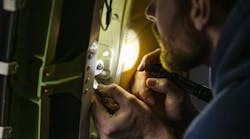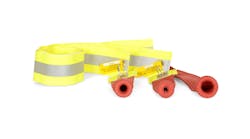Sulfidation — no turbine engine is immune from it. Since sulfidation tends to form in the blade root, shrouds, and to a lesser extent on the blade airfoil, it is a serious matter that requires constant monitoring.
Sulfidation (or sulphidation in some texts) exists in the blistering environment of a turbine engine hot section. Galvanic corrosion is an electro-chemical process that eats away aircraft structures and exists at normal temperatures. Sulfidation is a chemical process that occurs in high temperature environments, and typically has two types: Type I sulfidation occurs between about 1,500 F to 1,750 F (825 C to 950 C), and Type II sulfidation occurs in the 1,300 F to 1,500 F range (700 C to 800 C).
One definition of sulfidation is a reaction of a metal or alloy with some form of sulfur to produce a sulfur compound that forms on or under the surface of a metal or alloy. Sulfur in the fuel and airborne salts like sodium and chlorine reacts with the oxide layer on the blades in the high temperature environment of the turbine to attack the base metal of the blades. As a normal by-product of combustion, sulfur oxides are formed that combine with the salts and other elements ingested into the engine. This reaction forms sodium sulfates that expose the blade’s protective oxide layer to decay. Water is also produced as a by-product of hydrocarbon fuel combustion, and this water can combine with the sodium sulfur compounds to produce sulfuric acid.
How Does it Occur?
How does sulfur get into the engine in the first place? All hydrocarbon, or petroleum-based fuels contain trace amounts of sulfur after refining. The specification for Jet A, A-1 fuel (JP-8) allows a maximum of 0.3 percent by mass of sulfur, and this percentage goes up by 0.1 percent for other turbine fuels. No turbine engine is immune from this process, and since sulfidation tends to form in the blade root, shrouds, and to a lesser extent on the blade airfoil, it is a serious matter that requires constant monitoring. The blade root is obviously the worst place for corrosion to form, since weakening of the blade in this area can cause catastrophic turbine failure. Turbine blade airfoils are designed to decrease as much as possible the accumulation of the compounds that lead to sulfidation, and blade coating materials are used to keep the most corrosion prone areas of the turbine as corrosion free as possible.
The RB211
The Rolls-Royce RB211-535E4 engine is a triple spool high bypass fan type with a low pressure wide chord fan as the main propulsion element. The three-spool design provides a high bypass ratio in a short nose to exhaust cone space, and in the case of the RB211, a greatly simplified compressor section. There are no movable compressor guide vanes to tinker with, since compressor airflow control is done through a series of bleed valves. This design uses airflow bleeds from various compressor stages to cool the hot section through the use of hollow turbine blades and controlled bleed film cooling of the turbine wheels.
There is one high-pressure (HP) turbine wheel attached to a six-stage HP compressor, one intermediate pressure (IP) turbine wheel attached to a six-stage IP compressor and three low-pressure (LP) turbine wheels attached to a single-stage LP compressor (the fan). All turbine blades regardless of stage are attached to the turbine disks using the standard fir tree serration method. This arrangement retains the blades radially, and circumferential lock plates retain the blades axially. HP turbine blades are made from a directionally solidified nickel alloy casting, and there are 102 blades on HP turbine disk. Sulfidation corrosion is usually confined to the blade root shanks and shrouds in all stages of the RB211 turbine section, with light corrosion occurring on the airfoils.
Detection and Treatment
In contrast, on low bypass fan engines like the Pratt & Whitney JT8D Series, sulfidation is allowed on the turbine blades as long as blistering doesn’t cover more than 25 percent of the airfoil surface. Light corrosion is allowed on the entire surface of the blades, but these situations require monitoring on a flight hour basis. Another example is the P&W PT6 turboprop, where any sulfidation blistering or heavy deposits on the compressor or power turbine blades are cause for rejection. In these engines, blade airfoil sulfidation can be seen using a standard borescope and it can be assessed and monitored on-wing.
Because of the RB211’s design, sulfidation usually is not apparent on the blade airfoils unless it is heavily corroded, so detecting and removing it is left for engine teardown. The use of blade and turbine wheel cooling, blade design, and high efficiency airflow paths, fuel nozzles, and combustor designs lessens considerably the formation of sulfidation.
Because of the high temperatures in the HP turbine and the flow of cooling air through the blades, sulfidation has not been indicated in the blade internal passages. While general blade cleaning processes are similar, acid immersion times, abrasive blast cleaning, acidic descale processes, and masking requirements vary from one blade type to another. HP and IP blades require a nitric acid bath to remove sulfidation deposits, followed in special cases by a ferric chloride etch and abrasive blast to recondition the etched area. The blade airfoil and fir tree areas must be masked to prevent acid or etch solution contact in some instances, and abrasive blast cleaning is called out for fir tree serrations on some blades. If the corrosion extends into the fir tree attachment slots past acceptable limits, the blade must be scrapped. Blades that exhibit this much corrosion are most likely cracked and will require replacement anyway.
IP turbine blades have different inspection and cleaning requirements. In addition to root shank and shroud corrosion, internal passage sulfidation is possible on the IP blades. If sulfidation is suspected in the internal passage, a magnetoscope is required to check for areas of corrosion in the blade throughout its length, and any readings past maintenance manual limits require blade rejection. IP blades also carry an aluminized coating that through service bulletins has been extended to noncontact areas of the shroud for added corrosion resistance. There is also a service bulletin that provides a chrome coating in the blade shank prior to application of the aluminum coating.
LP blades are inspected in a similar way to IP blades, and there are additional checks made using fixtures and visual inspections. Cleaning LP blades requires an acidic descale process, and if the corrosion is more stubborn, acid immersion for up to three hours may be needed. Abrasive blast cleaning and fiber brush removal are approved for stubborn deposits. Since inspection and cleaning processes are different for each blade, and special inspections and cleaning processes may be required, it is best to consult the applicable maintenance task for a given blade. Several service bulletins have addressed potential service issues concerning IP and LP turbine disks and blades. The fir tree serrations in the turbine disks have been coated with sermetal, which is a sacrificial coating, and there are also chrome and aluminum coatings that are used on the turbine blades.
These coating processes and the high efficiency nature of the RB211 Series engines keep sulfidation to a minimum in the turbine section.
Depending on the engine make and model, sulfidation corrosion may be easy to spot using normal inspection techniques. A little time spent here could save an unscheduled trip to the overhaul facility, or worse, a catastrophic turbine failure that could take someone’s life.


